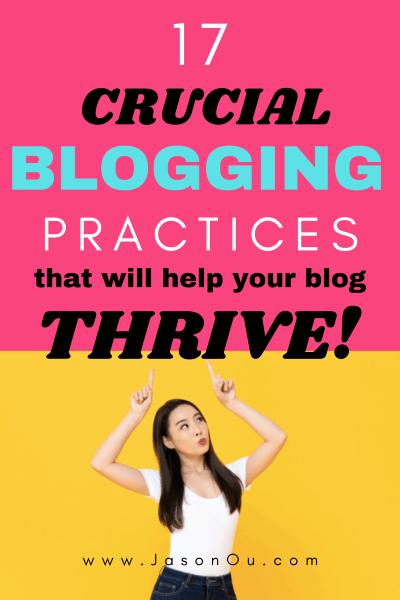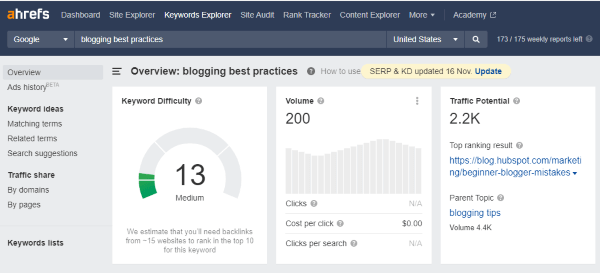17 Blogging Best Practices That Will Help Your Blog Thrive 2025
Not long ago, my seven-year-old daughter told me, “Dad, I’m going to use the internet and write stories all day to earn money.”
Easy said than done kid. Because blogging is fantasy.
Wannabes think it’s easy to pump out content and then realize it isn’t.
Then there are other factors. Like algorithms, driving traffic and leads. And more. Plus a few mess-ups in between.
That’s normal for blogging beginners.
That said, if you’re looking to get a leg up, here are the proven blogging best practices you should sink your teeth into.
Ignore them and you risk being a wannabe who tried for years. Get them right and you can kickstart a serious business.
And if you’re wondering if my daughter ever started blogging. Not yet.
I think she completely forgot it because, after her off-the-cuff comment, she was off playing with her rainbow pony toys.
Anyway. Before I pull the curtains on the best practices for blogging, I like to cover this point.
Why Do Bloggers Fail?
Bloggers fail for a lot of reasons. But the biggest reason is that they treat blogging like a hobby instead of a business.
And when you don’t treat your blog like a business, you’ll never see it reach its full potential.
Blogging takes effort, time, and attention if you want to be successful. Not only do you need to write killer content, but you also need to promote it too. That’s why so many bloggers fail.
They don’t realize that they need to put in the work if they want to see results.
Other blogging mistakes to avoid.
- Not planning and researching.
- Not getting what the audience wants to read.
- Ignoring blogging SEO best practices.
- Not promoting your blog to potential readers from other platforms like social media, email, and so on.
- Not growing an email list of the best prospects.
Look. I believe anyone, including my daughter, can launch a blog.
But you need to be in it for the long haul and give it the attention it needs to thrive.
So get off the silly fantasy train and focus on these SEO blogging best practices and tips.
17 Essential Blogging Best Practices 2025
1. It’s Not About The PJs?
Image courtesy of Pexels
If you want to be a successful blogger, it’s important to know the goals of your blog before you start writing.
No. I don’t mean working from home in your PJs full time and having more time with friends and family.
What I mean is. What’s your purpose for blogging?
Are you looking to build an audience for an existing business?
Do you want to make money from your blog through ads, affiliate income, or selling products?
Do you want to increase your email subscription?
Knowing the reason or reasons why you need to blog will give you a purpose and help you achieve your objectives.
Without a clear purpose, it’s easy to get lost in the sea of blogs out there and your blog will quickly become just another forgotten corner of the internet.
So take the time to figure out what you want to achieve with your blog, and then start crafting content that will help you reach those goals.
2. A Niche That Doesn’t Pay Sucks.
It’s no good deciding to make money from ads and then picking a small niche like this particular post, Blogging Best Practices.
Display ads need a huge amount of traffic to make a good income.
You need to be writing about topics that will generate views and clicks.
Otherwise, you’ll just be wasting your time.
To have a successful blog, you must be crystal clear about how your blog will make money.
If you’re unsure, check out other bloggers in your niche.
You can learn plenty from researching your competition.
So study how their blog is making money.
And if their methods don’t fit with what you’re trying to do, move on to another niche.
Because you want to make money blogging.
3. It’s Not About You.
Everyone has a story to tell or product to sell. Know your audience before you open your mouth. – April Sims
It’s about your readers.
One of the most important aspects of creating a successful blog is understanding what your audience wants to read.
- What are their dreams and aspirations?
- What keeps them up at night?
- What are their pain points or struggles?
- What topics do they devour?
Identifying what moves them is essential in creating content that will grab their attention.
It’s also important to make sure that your posts are relevant to the overall topic of your blog.
If you have a digital course on clean eating, for example, write tips for clean eating or the basics of clean eating.
This will help ensure that there is a match between what you’re promoting and what you’re writing about.
By creating content your audience cares most about, you are putting your audience first and building trust.
4. Write Kick-Ass Content.
Before I dive in, I want to clarify one of the blogging best practices.
How often should you blog?
Should you post daily or should you post X time a week?
A lot of people get confused about this and think that they need to publish multiple times a day, or even multiple times a week, in order to be successful.
But that’s not true at all!
When I first started, I was stumped by it too.
The mistake I made was to post every day. It was a huge struggle because I found it too hard and too difficult to maintain the quality of each post.
I felt overwhelmed.
It was only when I decided to focus on one blog post each week that I found my sweet spot. It was a schedule I could stick to.
Here’s the point. It’s more important to focus on quality over quantity.
Here’s what Hubspot has to say.
If you’re a marketing team of one, don’t feel the need to constantly pump out content. If you do, you’ll probably find yourself getting burned out and releasing content that’s not beneficial to you or your audience.
Keeping a schedule when blogging is important for two reasons. First, it builds organic traffic. Next, it helps with brand awareness.
Let’s be honest–you’re not going to become the best writer ever just because you start a blog. Or magically have this ability to design jaw-dropping graphics for your blog posts (unless you’re a graphic designer).
But you do need to show up with your best work.
Writing the best content possible is more important than churning out mediocre posts just for the sake of it.
So if it takes you a week to write one great post, that’s totally fine.<
Just make sure you’re being consistent with your posting schedule. And if you can only post once a month, that’s fine too!
Just make sure each post is awesome. 🙂
And if you are not confident with your writing, here are a few content marketing options that don’t require writing.
5. Don’t Lose Those Eyeballs.
Once you’ve got eyeball traffic coming to your blog, what’s the next step?
You have to convert those visitors into leads.
Why?
Because a first-time visitor to your blog will have no idea who you are and will be skeptical.
And that’s normal.
So it’s our job to try and build trust.
One effective method is to offer a free lead magnet.
A lead magnet is something that you give away for free in exchange for a reader’s email address (using an automated marketing system).
It could be a white paper, an ebook, a checklist, or anything else that would be valuable to your target audience.
By offering a free lead magnet, you can entice people to sign up for your email list.
An email list provides you with a way to stay in touch, lead with more free content, build a relationship, and then make promote to later.
The sweet thing. The email subscribers are yours.
If you take anything away from any of the best blogging practices, an email list is a must-have!
So don’t ignore the power of an email list.
6. Cherry Pick Your Keywords.
Image courtesy of Pexels
It’s no secret that blogs can be a great way to drive traffic to your website. But if you’re not carefully choosing the right keywords for your blog posts, you’re setting yourself up for failure.
In other words, you will have zero chance of ranking on google and driving organic traffic to your blog.
And when people can’t find your blog posts when they’re searching for relevant information, they’re not going to bother reading them.
And if nobody’s reading your blog posts, they’re not going to do you any good.
So what are the best practices for blogging when it comes to picking the right keywords?
First of all, you have to understand that keywords are simply phrases people use when they search on Google.
And second of all, you need to pick keywords that are relevant to your blog post topic.
If you try to rank for keywords that are too general, like blogging, you’ll have no way in hell to get your blog noticed.
But if you choose keywords that are too specific, nobody will be searching for them. So it’s all about finding that happy medium.
Take for example this post, the main keyword I’ve targeted is Blogging Best Practices.
According to Ahrefs, a keyword tool I use shows that a keyword, like Blogging Best Practices, has a difficulty score of 13.
This keyword is something that I could potentially rank for.
Because I can see a few sites have low DAs, and a low number of one-way links, and overall, it is not that competitive.
Here’s a snapshot below.
For a new blog, I suggest starting with less competitive keywords and then working steadily up over time.
More importantly, it has to be a blog topic that will benefit your readers.
I like to say this again.
Once you’ve picked the perfect keywords, focus on writing compelling blog posts that will encourage people to stick around and read what you have to say.
If you can do that, you’ll be well on your way to driving some serious traffic to your website.
Blog SEO Best Practices – On Page
7. The Bones.
Ok, before we move on. I’m assuming here, you’ve nailed down some of the blogging best practices above. That is.
- You are in a profitable niche.
- You have cherry-picked a few non-competitive keywords to go after.
- You’re focused on blogging the best content for your readers.
- You’re ready to build an email list of high-quality leads.
But, that’s just one part of the blog post.
However, this is where rookie bloggers make this common mistake.
They think being a successful blogger is just about posting content, so they ignore the SEO stuff.
Wrong.
Without it, your blog will disappear into some dark abyss of the web.
So don’t fall for this blogging for beginners thinking.
On-page SEO is one of the most crucial blogging best practices you can do for your website.
Think of it as the solid bones of a blog post.
This means you have to optimize your website for the search engines so you have a chance to rank higher in the search results.
But Jason, what about social media?
Yes, you can drive traffic to your blog with social media.
But for long-term success, SEO trumps social.
You see.
When you get your SEO right, you’ll get a steady stream of traffic to your blog from Google for a long, long time.
But with social media, it’s short-term because what you post today will become yesterday’s news. It is temporary.
With that said. Here’s a 9-foot view of blogging SEO best practices.
Image courtesy of Pexels
Choosing the right keywords is essential for on-page SEO. You need to choose keywords that are relevant to your niche and that people are actually searching for.
Then research and back it up with content that is relevant to the search query. Again, it is putting your audience first.
Here’s what I normally do.
I would write the first draft without any keywords in them. The next day, I would edit it and improve the content. Double-check for spelling and grammar errors. Then add the keywords.
Add your main keyword strategically in your text:
Once you’ve selected your keyword, you need to add them strategically to your blog post. This means using them in the right places, such as in the title, URL, and meta description.
And adding them within the first 100 words, the content, and the last paragraph.
For an idea, check out where I strategically placed my main keyword, blogging best practices.
Add your related keywords strategically within your text:
This is a chance to get additional traffic from related terms that Google could potentially rank your blog post for.
Just add those terms within the body content and, if you can, within a subheading. But only do so if it makes sense to.
So, no keyword stuffing.
Take this post as an example. Some of my related keywords include best practices for blogging and blogging for beginners.
Side note: In this blog post, I have compiled 12 related keywords.
Creating click-worthy blog titles:
Think of your blog title as a little advert. It needs to be attention-grabbing and relevant to the topic of your post.
When done right, it can hook the reader in and compel them to click through to your blog post.
But creating catchy headlines takes practice.
For inspiration, geek over popular magazines and grab some ideas from their copywriters.
I suggest brainstorming 5 to 10 blog titles before you decide on one. Because you have to make sure your blog post gets seen and read.
And two more things. Make sure the title includes the main keyword and is less than 70 characters.
Does your post have the right length:
Not every blog post has to be super long.
For an idea of the length of a post, check out the blogs that are on the front page for your keyword.
As well, get a feel of the kind of posts that are being produced so you can come in at a different angle and fill in any gaps.
If it is between 800 to 1000 words, your article length should be in that range, or better still longer. Again, your article needs to be useful for the reader.
Make it count.
That said. Here are six blog writing best practices.
- Your blog post title needs to make readers curious and give them the benefits of reading the article.
- The opening sentence has to pull the reader into the rest of the post. Make the first sentence count.
- Stay away from big chunks of text. It’s a big turnoff.
- Write one to three-line paragraphs.
- Break up your text with images, videos, infographics, and subheadings to keep your readers engaged.
- Have a call to action on the blog post.
Meta matters:
Your meta description is what appears in the search results beneath your blog title. It needs to be enticing and relevant to the topic of your post.
Again, include your main keyword and if possible, your related keywords in the meta description.
Optimize your blog post URL:
For SEO, I suggest adding your primary keyword to your blog post URL. But keep it short.
For example, check out this blog post URL. I have my main keyword, blogging best practices, in the URL.
Does your post have the right length:
Not every blog post has to be super long.
For an idea of the length of a post, check out the blogs that are on the front page for your keyword.
As well, get a feel of the kind of posts that are being produced so you can come in at a different angle and fill in any gaps.
If it is between 800 to 1000 words, your article length should be in that range, or better still longer. Again, your article needs to be useful for the reader.
Make it count.
Boost your page loading speed:
Page speed is a crucial factor for both SEO and user experience.
Make sure your website loads quickly by optimizing images, using caching, and minifying code.
A caching plugin like WP Rocket can help speed up your loading time.
Internal linking:
Linking to other pages on your website helps users navigate your site and most of all, keeps them engaged on your blog longer.
It also tells search engines that your site is comprehensive and informative.
External linking:
Linking out to high-quality websites helps improve both your SEO and reputation. Only link to websites that are relevant to your post.
HTTP:
If you want your blog to get noticed by Google, then HTTPS is a must-have.
You see. Securing your website with HTTPS helps improve both security and SEO. Plus, Google favors HTTPS websites in their search result.
Plugins:
Some awesome WordPress plugins can help boost the performance of your blog. You can read some of the best blog plugins for WordPress here.
Mobile Responsive:
Be sure to choose a mobile-ready theme. Because …
As of August 2022, 62.06% of all website traffic comes from people using mobile devices. – ExplodingTopics
Blog SEO Best Practices – Off Page
8. Skip Link Building.
Because you have to scour the internet for the right blogs in your space to work with.
It’s difficult.
It’s time-consuming.
It’s hard to get a link with a low domain authority.
It’s even more challenging to get a high DA link.
Even if you outsource this part of the work, it’s going to cost you. Big time.
9. But, It is Currency.
Think of a backlink as a vote for your website.
In a nutshell.
The more one-way quality links you have, the more Google will pay attention to the blog post, rank it quickly, and the more people will find your site.
The most effective backlinks are those that are relevant to the content on your site.
For example, if you have a blog about gardening, then a backlink from a gardening forum would be more effective than a backlink from a general-interest website.
If you’re looking to increase the number of backlinks to your blog, then there are a few things you can do.
First, try guest posting on other blogs in your niche. Although you will have to do some outreach and relationship-building, the long-term benefits are huge.
When you can provide value to their readers, not only can you build links and drive referral traffic to your blog, you’ll be showcasing your expertise and getting your name out there.
And develop relationships with other content creators.
Second, you can try broken link building. This is where you reach out to bloggers in your niche, email that their external link is broken and your post is a viable option in their resource.
Finally, another form of link building is passively getting links without any active involvement on your part.
But you have to be sure that your blog post is link-worthy by providing relevant and useful content that other bloggers will want to link to.
To level up the blog post, you can even include statistics, visuals, videos, case studies, and other unique information
This is worth repeating. Your content needs to be unique and informative for website owners to share.
That’s just some of the best blogging practices for link building.
Before I cover the rest of the best blogging tips, I need to point out that your SEO results will take time.
Depending on the keyword choice and the rest of the SEO geeky stuff you have to carry out, you’ll have to give your post between 6 to 8 months to see any kind of results.
So even if you feel frustrated with your lack of progress, keep up with the blogging best practices!
The work you’re putting in now will pay off later.
Don’t Puss Around
10. Stick to It.
There are a couple of reasons why you should blog consistently.
First, Google likes updates. When you have a new post, it shows that your website is active.
Second, your readers like to see new content. If they see that you’re regularly posting new and interesting articles, they’re more likely to come back and read more of your work.
Finally, consistent blogging helps to build up a database of content that you can use in the future.
If you have an old post that’s getting some traction, you can always update it and repost it.
This way, you’ll get the benefits of consistent blogging without having to come up with new ideas all the time.
Of course, consistency isn’t always easy. Life can get in the way, and sometimes it’s hard to find the time or inspiration to write.
But if you commit to being consistent, it will pay off in the long run. Your readers will appreciate it, and your blog will be all the better for it.
11. Be Engaging.
As a blogger, it’s important to encourage engagement on your blog.
This can include replying to comments, writing content that keeps readers on the page, and keeping the writing light and friendly.
Why is this worth doing?
Well, engagements are one of the factors that can help with your rankings.
The more engagements you have, the higher your blog will rank. And if your blog ranks higher, that means more people are likely to see it.
So encouraging engagement is a great way to get more eyes on your blog. Plus, it’s just good manners!
If people take the time to comment on your blog, the least you can do is reply. So take the time to interact with your readers and make them feel valued.
It’ll pay off in the long run.
12. Let People Know About It.
Your content is useless if no one is reading it now.
So why not get your blog noticed via your social media page, post on another blog, answer questions on Quora, use paid ads, Pinterest marketing, or even syndicate your content so you can drive traffic to your website?
Because with SEO, it will take at least 6 months before you see any kind of search results.
Here’s an interesting statistic from Statista. According to their online survey.
90% of bloggers worldwide used social media to promote their blog posts in 2021.
Start driving traffic to you blog as soon as it is published.
13. Think Amazon.
It took Amazon around nine years before it made its first profit.
The point. Don’t start a blog if you can’t commit to it.
It’s not a hobby.
If you want to make money online, treat your blog as a real business.
Like any business, building an online audience will take time.
You just have to keep on giving and posting epic content to attract more readers, later.
This means. You have to be patient before you see significant results.
14. Where Are They?
Because you want to be where they are!
You don’t want to waste your time on a social media platform that no one in your target audience is using.
When I started blogging, I made the mistake of trying to be everywhere. It was time-consuming and I wasn’t nailing down the strategy needed to move forward.
And I found myself thinking, how useful were all these?
Since then I’ve focused on two platforms, mainly Facebook and Pinterest.
So do yourself a favor. Think about where your audience is spending their time and focus your efforts there.
Join them. Add value to the group, the forum, or whatever platform it is by answering questions they need help with. Then direct them to your blog.
15. Plan Future Content.
When you blog, it’s a good idea to plan your posts ahead of time.
This way, you can make sure that you are writing about topics that people are interested in and that you have enough content for a while.
You can do this by thinking of keywords that people might use to search online and then planning posts around those keywords.
Before deciding which keywords to target, consider how popular the keywords are (search volume), how difficult it will be to rank for them (difficulty scores), and your gut feeling about whether you can rank high for a keyword.
Stay on top of your content management.
16. Get Horny With The Numbers.
Image courtesy of Pexels
I mean the PG stuff.
Of all the blogging best practices listed here, you should get excited with the numbers and the statistics.
Analyzing your content’s performance is essential if you want to understand how effective your blogging strategies are. Knowing what works and what doesn’t work can help you improve your blogging skills and create content that resonates better with readers.
First, analyzing the performance of your blog posts can provide insights into which topics are most interesting for readers, as well as what strategies you should use for SEO and other blogging efforts.
You can also look at how many visitors are clicking through to your blog posts from search engines, social networks, and other sources.
Second, analyzing content performance can help you identify opportunities for improvement.
For example, if you find that certain topics do particularly well, you can focus more of your blogging efforts on those topics, or if certain posts are not doing well, you can tweak them to make them more effective.
Finally, analyzing your blog posts allows you to measure the success of specific blogging strategies over time. By tracking how readers engage with your blog posts, you can adjust your blogging tactics and make sure that you are meeting your blogging goals.
If you want to view detailed statistics about your website traffic, Google Analytics and Ahrefs are great tools.
To gain an insight into your blog performance, you should already have Google Analytics installed. With it, you’ll be able to access metrics like the total number of site visitors, average time spent on each page, and overall page views from the dashboard.
You can even check the traffic for each blog post and see how it changes over time. This lets you know if your readership is going up or down.
Analyzing your content performance is key to understanding what works and how to improve your blogging efforts for better results.
So get high on numbers.
17. Ditch Blogging.
Image courtesy of Pexels
It’s ok to forget about blogging for one or even 2 days. You’ve got a life.
So hang out. Play golf. Watch K-drama. Have sex on the couch. Whatever.
Rejuvenate and get inspired for the next day.
FAQs – Best Practices For Blogging?
Why blogging is important?
As well, blogging can provide your business with multiple advantages, allowing you to create meaningful connections with potential customers and help your ranking on search engine results pages.
Other great reasons to blog include
- It builds loyalty and trust with readers.
- It can help you establish yourself as an industry expert and thought leader.
- It is a great way to drive traffic to your website, which can lead to more sales and revenue.
- It drives engagement.
- It increases your visibility on search engines, multiplying the potential for more visits and leads.
- It allows you to understand your readers’ needs.
Here’s a recent article I wrote about benefits of blogging for your business here.
How many blog posts before launch?
When you’re first starting a blog, it’s important to have a backlog of at least 10-15 posts ready to go before you launch.
This will give you a solid foundation to start attracting meaningful traffic to your site.
Of course, once you’re up and running, you’ll need to keep adding new content regularly to maintain a good following and sustain decent traffic levels.
But getting those initial blog posts written is essential to get things off to a strong start.
And don’t forget to promote each blog post so you can generate traffic to it.
So if you’re thinking about starting a blog, make sure you have a good selection of blog posts lined up before you launch! And apply the best practices for blogging.
What are the best practices for blogging?
Here are 17 blogging best practices.
- What’s The Goal Of Your Blog?
- Pick a Niche That Pays.
- Plan your future content.
- Write for your readers and be helpful.
- Blog Kick-Ass Content You Can.
- Build an email list of red hot leads.
- Cherry Pick Your Keywords.
- Apply on-page SEO to optimize your blog post.
- Build one-way links to your blog through guest blogging, broken link building, and so on. (Here’s an article I wrote on how to get your blog noticed by the search engines.)
- Building an audience online takes time.
- Encourage engagement on your blog.
- Promote your blog on social and other platforms, like Medium and Quora.
- Think long-term.
- Hang out where your audience is, and add value to the group.
- Use Google Analytics and analyze the performance of every post.
- Have fun blogging.
- Enjoy some time away from blogging.
Round Up of Blogging Best Practices 2025
What I just mentioned have been true and tried best practices for blogging.
For rookies or struggling bloggers, if you want to limit the mistakes and turn your blog into a passive business-building machine, then don’t skip any of the best blogging practices.
Need an assist with your blog? I’ve got you covered. Here’s a simple 7-step blogging checklist to help you launch a blog. Download your copy now to become a smarter blogger.
You Might Want to Check This Out Too
Want to get traffic to your blog but you hate the idea of social marketing? – Discover the best ways to generate red hot leads to your website without social.
Resources To Grow Your Business With
Bluehost is a great starting point for beginners or bloggers who want to switch to a reliable web hosting service. And it gives you the best bang for your buck – starting at $2.95 a month*.
With the entry-level hosting plan, you’ll get a free domain name for one year, free SSL, free CDN, reliable customer support, and 30 day money back guarantee.
You can sign up with Bluehost here.
WPX Hosting
It’s a web-hosting service I love using. It specializes in WordPress hosting, and depending on what package you opt for, you can host 5 or more sites on one account. The best bit is – the quick turnaround in support is top notch.
For bloggers who have an established blog, this is a fantastic option.
You can learn more about this service here.
Aweber
Building an email list of a growing audience is essential for the longevity of any business. This autoresponder service is easy to use, and it is a great starting point for someone looking to kickstart their email campaign. You can try their free account here.
Hi, I’m Jason Ou (surname aka, Oh). I am a Solopreneur and Blogger. My mission is to help fellow entrepreneurs (like you) to profit from their passion online. Let’s connect on Facebook now.









